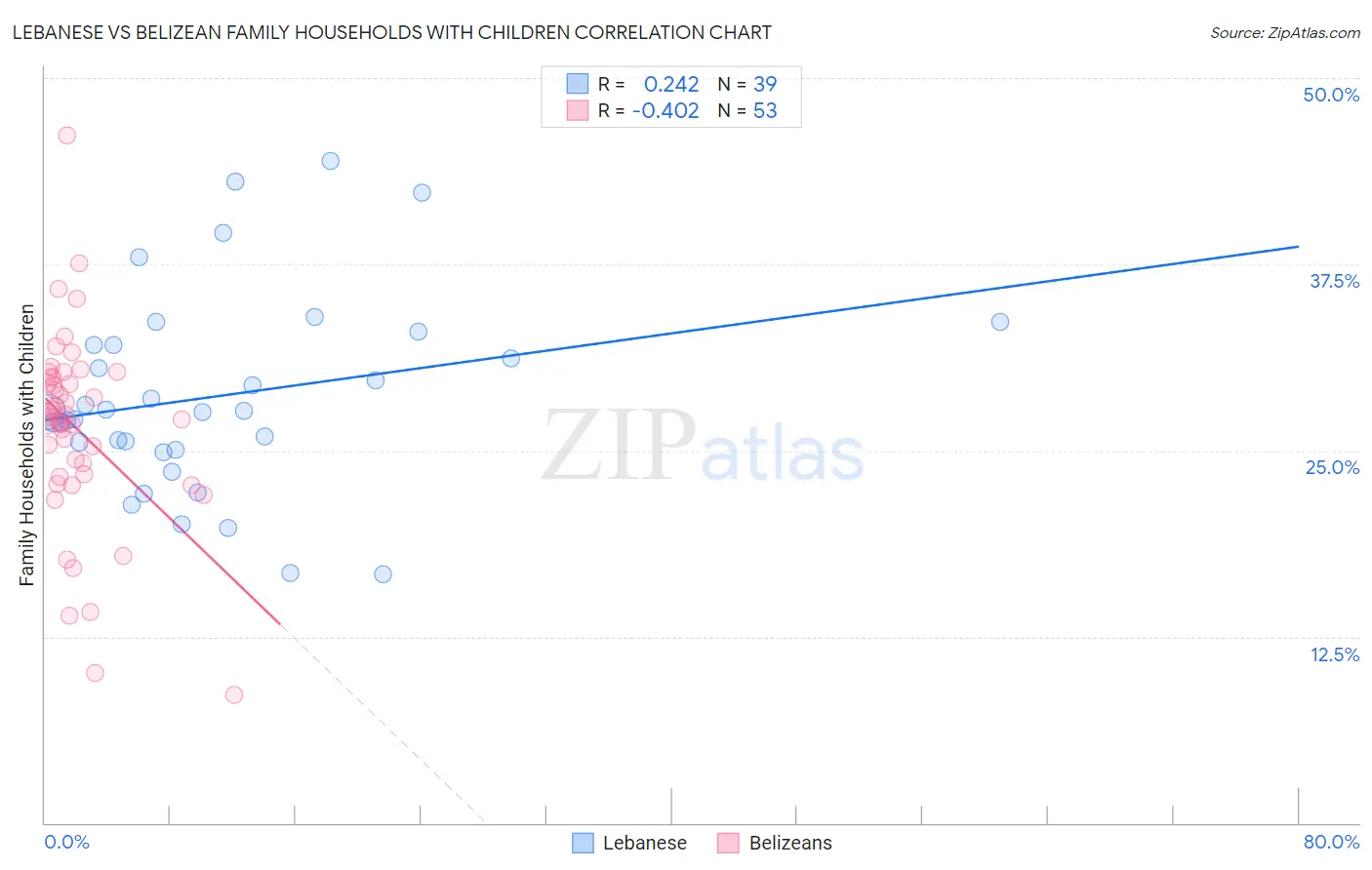Lebanese vs Belizean Family Households with Children
COMPARE
Lebanese
Belizean
Family Households with Children
Family Households with Children Comparison
Lebanese
Belizeans
27.7%
FAMILY HOUSEHOLDS WITH CHILDREN
87.4/ 100
METRIC RATING
131st/ 347
METRIC RANK
27.8%
FAMILY HOUSEHOLDS WITH CHILDREN
90.0/ 100
METRIC RATING
127th/ 347
METRIC RANK
Lebanese vs Belizean Family Households with Children Correlation Chart
The statistical analysis conducted on geographies consisting of 401,138,996 people shows a weak positive correlation between the proportion of Lebanese and percentage of family households with children in the United States with a correlation coefficient (R) of 0.242 and weighted average of 27.7%. Similarly, the statistical analysis conducted on geographies consisting of 144,146,110 people shows a moderate negative correlation between the proportion of Belizeans and percentage of family households with children in the United States with a correlation coefficient (R) of -0.402 and weighted average of 27.8%, a difference of 0.14%.

Family Households with Children Correlation Summary
| Measurement | Lebanese | Belizean |
| Minimum | 16.7% | 8.6% |
| Maximum | 44.4% | 46.2% |
| Range | 27.8% | 37.6% |
| Mean | 28.6% | 26.4% |
| Median | 27.6% | 27.3% |
| Interquartile 25% (IQ1) | 25.0% | 23.3% |
| Interquartile 75% (IQ3) | 32.1% | 29.9% |
| Interquartile Range (IQR) | 7.1% | 6.6% |
| Standard Deviation (Sample) | 6.6% | 6.5% |
| Standard Deviation (Population) | 6.5% | 6.4% |
Demographics Similar to Lebanese and Belizeans by Family Households with Children
In terms of family households with children, the demographic groups most similar to Lebanese are Cajun (27.7%, a difference of 0.010%), Immigrants from Belize (27.7%, a difference of 0.080%), Immigrants from Eritrea (27.8%, a difference of 0.10%), Iranian (27.7%, a difference of 0.10%), and Syrian (27.8%, a difference of 0.12%). Similarly, the demographic groups most similar to Belizeans are Syrian (27.8%, a difference of 0.020%), Immigrants from Ethiopia (27.8%, a difference of 0.030%), Immigrants from Eritrea (27.8%, a difference of 0.040%), Immigrants from Singapore (27.8%, a difference of 0.050%), and Ecuadorian (27.8%, a difference of 0.050%).
| Demographics | Rating | Rank | Family Households with Children |
| Zimbabweans | 95.6 /100 | #119 | Exceptional 27.9% |
| Europeans | 95.4 /100 | #120 | Exceptional 27.9% |
| Immigrants | Western Asia | 93.6 /100 | #121 | Exceptional 27.9% |
| Immigrants | Zimbabwe | 92.8 /100 | #122 | Exceptional 27.8% |
| Immigrants | Northern Africa | 91.8 /100 | #123 | Exceptional 27.8% |
| Immigrants | Singapore | 90.8 /100 | #124 | Exceptional 27.8% |
| Ecuadorians | 90.8 /100 | #125 | Exceptional 27.8% |
| Immigrants | Ethiopia | 90.5 /100 | #126 | Exceptional 27.8% |
| Belizeans | 90.0 /100 | #127 | Exceptional 27.8% |
| Syrians | 89.7 /100 | #128 | Excellent 27.8% |
| Immigrants | Eritrea | 89.4 /100 | #129 | Excellent 27.8% |
| Cajuns | 87.6 /100 | #130 | Excellent 27.7% |
| Lebanese | 87.4 /100 | #131 | Excellent 27.7% |
| Immigrants | Belize | 85.7 /100 | #132 | Excellent 27.7% |
| Iranians | 85.2 /100 | #133 | Excellent 27.7% |
| Immigrants | Panama | 84.9 /100 | #134 | Excellent 27.7% |
| Immigrants | Ecuador | 84.6 /100 | #135 | Excellent 27.7% |
| Immigrants | Portugal | 84.1 /100 | #136 | Excellent 27.7% |
| Immigrants | Dominican Republic | 83.9 /100 | #137 | Excellent 27.7% |
| Uruguayans | 83.2 /100 | #138 | Excellent 27.7% |
| Vietnamese | 82.6 /100 | #139 | Excellent 27.7% |